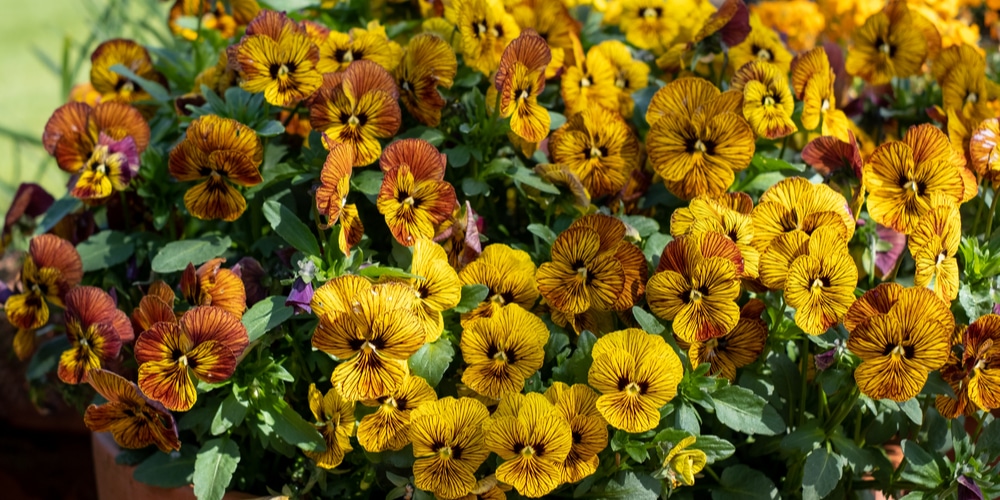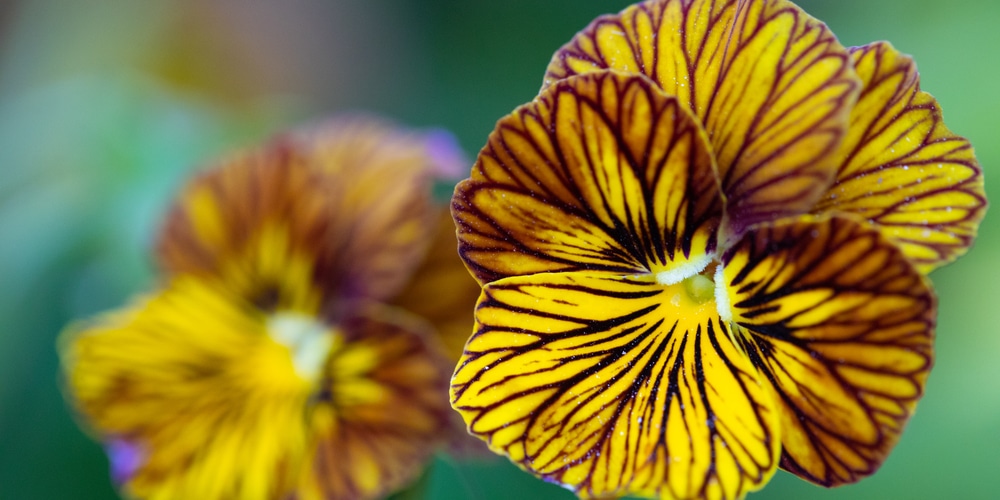Pansies are one of the best flowers to brighten up any garden, and the Tiger Eye Pansy is no exception. Tiger Eye Pansies, also known for its botanical name Viola x wittrockiana, is a unique perennial that is commonly grown as garden beddings.
These pansies are larger than the common species of violas. They have heart-shaped golden petals with a unique black veining that resembles a tiger’s eye.
They are ideal for adding color to shady areas of the garden and make excellent groundcover.
| Botanical Name |
Viola x wittrockiana |
| Common Name | Tiger Eye Pansy |
| Plant Type | Perennial |
| Flower Color | Multicolor, Orange, Yellow |
| Size When Mature | 9 to 12 inches wide, 6 to 9 inches tall |
| Bloom Time | Fall, Spring into early Summer |
| Sun Requirements | Full/ Partial Sun |
| USDA Hardiness Zones | Zones: 4 – 9 |
| Soil PH Range | 6.5 – 7 |
| Soil Type | Slightly acidic to neutral |
| Water Needs | Medium |
| Native Area | Europe and Asia |
What You Need to Know About Tiger Eye Pansy
The tiger eye pansy (Viola x wittrockiana) is a hybrid of two Viola species, V. tricolor, and V. lutea. It is a low-growing bushy plant that is great for garden beddings and boarders. This variety of viola is commonly cultivated during spring or summer, but some are known to have been bred to bloom during the winter season.
It is a popular garden plant, grown for its showy flowers which appear in shades of yellow, orange, purple, and white. The petals contrast beautifully with its dark-green foliage.
In addition to its delicate characteristics, the tiger eye pansy is not known to have any toxic side effects on humans, livestock, or domestic animals. They can be eaten as a garnish and sometimes candied and used as a decorative cake topper.
How to Care for Tiger Eye Pansy
The plant is also easy to grow from seed which makes it one of the most popular cultivars.
Here’s everything you need to know about growing and caring for a thriving The Tiger Eyes Pansies.
Light
When it comes to flower gardening, few plants are as versatile or easy to care for as the Tiger Eye Pansy. A member of the Viola genus, Tiger Eye Pansies can thrive in a variety of conditions, from full sun to partial shade.
If grown indoors tiger eye pansies should be placed in an east-facing window to receive the morning sun. As pansies prefer partial to full sun to thrive, rotate the pot every few days so that all sides of the plant receive an equal amount of light.
Water and Soil Needs
While the Tiger Eyes pansy is relatively easy to care for, it does have some specific soil requirements. This plant prefers humus-rich, well-drained soil that is high in organic matter.
If you want your pansies to thrive and bloom, water them regularly, especially during hot weather.
The soil should also be slightly acidic, with a pH level between 6.5 (slightly acidic) and 7 (neutral). If the soil is too alkaline, the flowers may develop brown spots.
Temperature Requirements
Tiger Eye Pansies are not tolerant of frost and should be protected from cold weather. It grows well in USDA zones 4-9, and it is best to mulch the plants with straw or leaves in late fall. In colder climates, Tiger Eye Pansies can be grown as annuals.
Fertilizer
The best fertilizer to use on Tiger Eye Pansies is a slow-release fertilizer that is high in phosphorus. This will help promote blooming. Fertilize the plants every 4 to 6 weeks during the growing season.
You should also be wary of fertilizers that are nitrogen-heavy as they will result in producing more foliage than flowers.
Common Diseases
Tiger Eye Pansies are relatively pest and disease resistant but may be susceptible to aphids, slugs, and root rot. These pests can be controlled with insecticidal soap or neem oil.
To prevent root rot, make sure the soil is well-drained and avoid overwatering. If the plant does develop root rot, remove it from the pot and replant it in fresh soil.
Tiger Eye Pansies Propagation
Deadheading is the process of removing spent or dead flowers from a plant. This can be done by simply snapping off the flower at the stem, or by cutting back the stem to a leaf node. Deadheading not only tidies up a plant but also helps to encourage new growth.
In the case of tiger eyes pansy, deadheading will encourage the plant to produce new blooms. This is because the plant uses its energy to produce seed pods, rather than new flowers.
By removing the spent flowers, you are signaling to the plant that it should direct its energy toward creating more blooms. It is a simple task that can make a big difference in the health and appearance of your plants.
Pansies can also be cut back by half in late summer to promote fresh growth in the fall. This may sound counterproductive but there is a logical explanation for this procedure.
When the days start to get shorter, pansies begin to produce fewer flowers. By cutting back the plants, you stimulate new growth and encourage the formation of new buds. As a result, you will have a fuller, more colorful display of pansies in the fall.
Related Article: What to Do With Pansies in the Summer?

